Thanks to the Great War Museum, Meaux is now a must-see for people interested in this conflict. Its historical centre also boasts major gothic and medieval religious buildings.
[ Practical ]
Getting there
- By road
45 km from Paris on road N3, 55 km on autoroute A4
- By train
Suburban train from Paris Gare de l’Est to Meaux. The journey takes from 25 mn to 40 mn.
Lodging
Ibis Style
Hôtel Le Richemont
Restaurants
Maison Dugast
La Grignotière
Un Goût de Nature
Getting around
Buses M6, 10, 11, 63 and 65 run from the town centre and the railway station to the museum
Musée de la Grande Guerre
Rue Lazare Ponticelli, 77100 Meaux
Open every day except Tuesday from 9.30am to 6pm. Closed on January 1st, May 1st and December 25th.
Admission : €9 / €7
www.museedelagrandeguerre.eu
Information
- Seine-et-Marne Tourist Office
visit.pariswhatelse.fr
- Meaux Tourist Office
Tel : 0164330226
www.tourisme-paysdemeaux.fr
About forty kilometres east of Paris, Meaux is since November 2011 home to one of the best museums dedicated to WWI as much by the topics it tackles as by its extraordinary collection. A diverse mix of almost 50,000 objects and documents, it includes over 200 complete uniforms from 35 combatant nations, prostheses and other equipments designed for the war disabled, drawings, propaganda posters, photographs, newspapers, plenty of weaponry, gas masks, helmets, communications devices and personal items of soldiers.

 American Monument © Thierry Joly American Monument © Thierry Joly
|
 Monument to the victims of the Battles of the Marne Monument to the victims of the Battles of the Marne
Unparalleled anywhere in Europe, this collection was assembled over 40 years by one man, Jean-Pierre Verney, a self-taught private collector and war buff who gave it to the Meaux city council on the condition that it would be properly displayed and accessible to the public.
Setting up a WWI museum in this outer suburb of Paris may seem surprising to many people but there was a legitimate reason for doing so. On fall 1914, during the Battle of the Marne, one of the opening campaigns in World War I, the outskirts of the town were the closest the German troops got to the City of Light. That is why a 26 meters high white statue representing a figure of Liberty entwined with the dead and dying stands next to the museum. Officially called “Liberty in Distress” but locally known as the American Monument, it was presented to France by the United States in 1932.
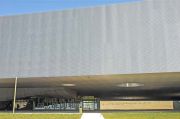
 Great War Museum © Thierry Joly Great War Museum © Thierry Joly
|
 Futuristic building Futuristic building
It was sculptured by Frederick MacMonnies and erected in memory of the soldiers who fell at the two battles of the Marne.
Surrounded with a park where discreet speakers play sounds of cannonade and troop movements, the museum is a modernistic silver slab of a building where the permanent collection occupies 3,000 sq meters and the modern display includes numerous screenings, sound broadcasts and interactive multimedia terminal. There is also a 300 sq meters room hosting two temporary exhibitions per year.
The visit starts in the far-off days of the late 19th century and the 1870 Franco Prussian war, and move through to 1914 recalling the revenge and military ethos instilled in young French boys, segues into the political crises that triggered the First World War.
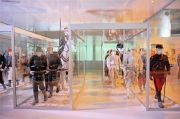
 Great War Museum © Thierry Joly Great War Museum © Thierry Joly
|
 Diorama of WW1 battlefield Diorama of WW1 battlefield
Then, visitors pass between display cases containing platoons of life-sized figures of French and German soldiers going to the front line led by three officers on horseback rendered in white polyester and resin. It leads them to the central gallery where is first given a brief overview of the war. However, most of this great nave is occupied a diorama representing a typical WW1 battlefield with a French trench, German trench and in between the feared no-man’s-land. Large vehicles and armaments are also on display including a Renault FT 17 tank, two aircrafts hanging from the ceiling, a 75-millimeter field gun and a “mobile field pigeon loft,” a movable menageries that held carrier pigeons, which provided the most reliable method for sending messages in the battlefield.
On one side of this nave are located trenches-like rooms where are screened very interesting French, British and German archive black and white films showing battlefields and fighting scenes.
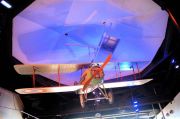
 Great War Museum © Thierry Joly Great War Museum © Thierry Joly
|
 Seldom addressed topics Seldom addressed topics
On the other side, there are several galleries each dedicated to a specific theme. In spite it’s a bit of a maze due to the architecture and a lack of signs, it is without doubt the most interesting part of the museum as several of these rooms evoke topics seldom addressed elsewhere. Let’s name the decisive role women played in the conflict, recruitment of troops in British and French colonies, support of the war by organized religions, scientific and medical advances in fields such as surgery, mental health cares and prosthesis that resulted from the need to treat the new wounds caused by the extensive use of heavy artillery and poison gases.
One gallery also focuses on the personal possessions of soldiers and highlights their creativity displaying objects that had been carved and shaped from war materiel in the trenches.
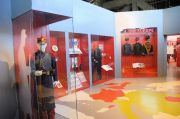
 Great War Museum © Thierry Joly Great War Museum © Thierry Joly
|
 Innumerable weapons Innumerable weapons
It features erotic reliefs cut in the brass casings of shells, bullets turned into salt shakers, mandolins and banjos made out of helmets, cigarette lighters fashioned from grenades and cartridges, religious talismans, homemade board games and playing cards….
Of course more classic subjects topics are tackled as well like the technological developments in such areas as artillery, camouflage, communications and equipment, the tactics and strategy, commitment to the war effort on the part of entire populations and the major part played by the American Expeditionary Force in the final victory. Armaments is not forgotten with an innumerable number of pieces ranging from pistols and bombs dropped by hand from primitive aircraft to medieval-like armors, daggers and clubs made out of exploded bombs for hand to hand fights in trenches.
Lastly, the final section of the museum deals with the consequences of the war, but it is of little interest. If your time is limited, only have a quick look and go to discover the historic centre of Meaux that is worth a visit.
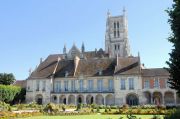
 Cathedral and bishop palace © Thierry Joly Cathedral and bishop palace © Thierry Joly
|
 Episcopal City Episcopal City
Nestled in a bend of the Marne, it reflects the past prosperity of this town that was for centuries one of the richest and most powerful in the North of France thanks to the important agricultural production of the surrounding farmland. Incidentally, the region gives its name to one of the most well-known French cheeses, the Brie de Meaux made from raw cow's milk, of course on the menu of all restaurants and still produced by local cheese diaries one of them being sometimes open to visit.
Still partly surrounded by a Roman wall reinforced with towers in the Middle Ages, this old quarter is organized around an Episcopal City built from the 12th to the 16th century. Every summer, it hosts a night show with sound and lighting effects as well as fireworks that brings together 500 actors. Its main feature is an imposing Gothic cathedral dedicated to Saint Stephen, supposedly inspired by Paris’ Notre Dame but never fully completed.

 Old Chapter © Thierry Joly Old Chapter © Thierry Joly
|
 Bossuet’s hometown Bossuet’s hometown
Besides, recognizable by its outside staircase, the Old Chapter was originally the seat of the chapter of the canons of the Cathedral and the tithe barn before being converted into a sacristy. Once coveted the post of bishop of Meaux was for a while occupied by Bossuet, a renowned 17th century preacher, writer and orator who, according to the legend, would meditate and write in the small pavilion built on the ramparts. He is buried in the cathedral where stands a monument in his honour and also gives his name to the French garden facing the bishop's palace as well as to the museum housed inside. Dating from the 12th – 17th centuries, the rooms contain a collection of French paintings from the 16th to 19th centuries including works by Le Nain, Van Loo and Millet as well as a series of 17th century pharmaceutical pots.
Finally, to end this discovery of Meaux, you can stroll through the surrounding streets where stand a few mansions from the 17th and 18th centuries and walk along the banks of the river Marne.
October 07, 2015
Thierry Joly 

|



